| Pages:
1
..
26
27
28
29
30
31 |
Herr Haber
International Hazard
    
Posts: 1236
Registered: 29-1-2016
Member Is Offline
Mood: No Mood
|
|
Good idea on the gas mask. A couple of different filters will also come in handy. They are expensive though depending on what they are for (NOx,
organic vapors, dust, etc.)
Keep in mind that you can overpower the filter of any gas mask. I can assure you that standing over a beaker full of boiling ammonia will make you cry
even if you're outside with the best mask in existance.
Check out Ordnance labs videos on Gas mask + tear gas on Youtube. The lesson from these videos is that you only lessen the risk but never negate it.
Pretty important to think about when you're exposed to NOx.
You can either set up an ammonia generator like Xeon suggests (though I'd keep that for times when I need anhydrous conditions) or use the 6% solution
you have. It should be easier on your eyes than 30+ % as it wont outgas as fast when you heat it. You'll just have more water to boil but that
shouldnt be a problem.
The spirit of adventure was upon me. Having nitric acid and copper, I had only to learn what the words 'act upon' meant. - Ira Remsen
|
|
|
ManyInterests
National Hazard
   
Posts: 966
Registered: 19-5-2019
Member Is Offline
|
|
I have a good distillation setup. I don't have that specific column that you have. I have a heating mantle with magnetic stirrer, an alihn condenser,
and a whole ton of good glass ware that has never failed me.
i have also ordered a simple magnetic stirrer (no heating) as sometimes I just need a good stirring system outside my mantle (and my mantle isn't that
good in stirring in beakers. I believe having a stirrer that I can stir things in when I have a beaker in an ice bath (which is impossible with the
mantle) will be very useful.
Can you list the glass ware you have there specifically? With the attachments and such. I am probably going to be in the market for those. I did find
them previously, but they were pricey.
So until I get those I will need to use my ammonia solution. I will have to rely mostly on the 6% solution (mostly with some 28% added in).
Does the picric acid need to be fully dissolved in liquid for it to turn to ammonium picrate, or is some saturated solution sufficient? I will not
add any picric until the solution is bubbling hot for obvious resaons.
[Edited on 1-12-2022 by ManyInterests]
|
|
|
Herr Haber
International Hazard
    
Posts: 1236
Registered: 29-1-2016
Member Is Offline
Mood: No Mood
|
|
For a simple gas generator you need:
1 dropping funnel with a glass stopper
1 flask (round with 2 necks, erlenmeyer with a side arm, etc).
Some tubing
If necessary a bubler or a pipette attached at the end of your tubing.
The flask can be the same one you use for vacuum filtration if the joint size is adequate.
I would recommend you put your picric acid in a suspension of ammonia water before turning the heat on, then proceed with small additions of ammonia.
If you do the way you suggest a lot of the gas will be lost before having any chance to react with the acid and it'll just be unpleasant longer.
You can add more ammonia until everything dissolves while heating to be 100% sure you converted everything. It's better to use an excess of ammonia;
you will get rid of it when heating to reduce the volume and get your product when it cools.
The spirit of adventure was upon me. Having nitric acid and copper, I had only to learn what the words 'act upon' meant. - Ira Remsen
|
|
|
XeonTheMGPony
International Hazard
    
Posts: 1641
Registered: 5-1-2016
Member Is Offline
Mood: No Mood
|
|
My method was fully dissolve the picric in distilled water under stirring, once a clear yellow solution was present, I started the ammonia generator
directly bubbling in the stirred solution, the ammonia generator was all ready at a simmer to ensure the ammonia was fully expelled.
this was run till a slight excess of ammonia was present determined by free ammonia smell
|
|
|
ManyInterests
National Hazard
   
Posts: 966
Registered: 19-5-2019
Member Is Offline
|
|
Thanks for the advice. Seems like picric acid is a journey in and of itself.
But I am having this issue. Last night I decided to filter out the picric acid from the beakers and do a re-recrystalization of the older batch and
concentrate the liquid of the other batch. But I have this issue.
I placed the picric acid on a sheet of aluminum foil to let it dry off, but I am seeing some discoloration. What is happening here? I hope it isn't
degrading my picric. It shouldn't form any other explosive salts. I transferred them to styrofoam plate covered with many layers of paper towel.
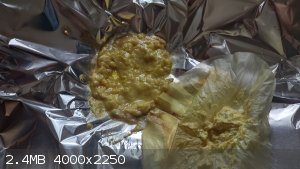
[Edited on 2-12-2022 by ManyInterests]
[Edited on 2-12-2022 by ManyInterests]
|
|
|
Herr Haber
International Hazard
    
Posts: 1236
Registered: 29-1-2016
Member Is Offline
Mood: No Mood
|
|
I dont know about aluminium picrate but I would never put picric acid in contact with a metal.
Besides, if you need something dry you're better off leaving it in it's filter paper and putting this filter paper on top of a few layers of paper
towel and a plate.
If wind / dust is going to be an issue put another plate face down to cover your product. It wont dry perfectly if you leave the plate over it though.
I recommend you move the product around with a plastic spoon to expose more moisture. You can also use wood (those disposable chop sticks are good for
everything!) but it will turn black.
Good towel paper should wick away moisture away from between the two plates in a couple of days in the worst conditions. Next to a heater during
winter can be very fast.
The spirit of adventure was upon me. Having nitric acid and copper, I had only to learn what the words 'act upon' meant. - Ira Remsen
|
|
|
ManyInterests
National Hazard
   
Posts: 966
Registered: 19-5-2019
Member Is Offline
|
|
I thought that picric acid didn't react with aluminum! now I know. So I'm not going to ever do that again. I even checked out the post made just
before I ressurected this thread... aluminum picrate exists! I have no idea how sensitive it is, but I hope it isn't dangerous. I'm going to use all
of what I made here in order to make the ammonium picrate.
https://chempedia.info/info/aluminum_picrate/
[Edited on 3-12-2022 by ManyInterests]
|
|
|
ManyInterests
National Hazard
   
Posts: 966
Registered: 19-5-2019
Member Is Offline
|
|
So I have a photo of my first two picric acid batches now drying. I have more that I am going to boil out of the remaining liquid (I have 800ml to
boil down to 300ml or so, collect what I can, and call it good for this round).
the colors are different. Is something up with it? Or is it OK? I know some of the discoloration on the plate on the left is due to the aluminum, but
the one on the right is one that I reboiled down (at 80C). The one on the left is boiled at a higher temperature before I realized that this is not a
good temperature to do it. Did I degrade that picric acid or what?
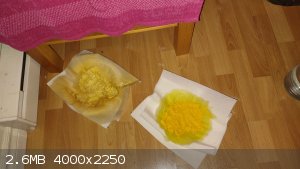
|
|
|
B(a)P
International Hazard
    
Posts: 1139
Registered: 29-9-2019
Member Is Offline
Mood: Festive
|
|
Looks like a different crystal size/shape? That would likely account for the difference in appearance.
|
|
|
ManyInterests
National Hazard
   
Posts: 966
Registered: 19-5-2019
Member Is Offline
|
|
Quote: Originally posted by B(a)P  | | Looks like a different crystal size/shape? That would likely account for the difference in appearance. |
OK good, as long as the purity of my product isn't compromised... except for the silly aluminium mistake, but I don't think that'll affect it that
much when turning all this to ammonium picrate.
It'll be a couple of days before they fully dry. I got time. I want to see my overall yield from these before continuing with anything else.
|
|
|
Herr Haber
International Hazard
    
Posts: 1236
Registered: 29-1-2016
Member Is Offline
Mood: No Mood
|
|
Like B(a)P says.
If you want to be sure dont combine the batches just in case you have some Al picrate in there. I really dont know the compound either.
There's litterally zero chance you degraded your product by heating it when recrystallizing it. It's melting point is far above the temperature you
can reach with water and it's decomposition even higher.
The spirit of adventure was upon me. Having nitric acid and copper, I had only to learn what the words 'act upon' meant. - Ira Remsen
|
|
|
ManyInterests
National Hazard
   
Posts: 966
Registered: 19-5-2019
Member Is Offline
|
|
Well it's kinda too late when it comes to combining batches since I put them both together (albeit I will keep this one separate from the next two
batches I intend to make). I don't think aluminium picrate is that dangerous, but then again it might... at any rate, I will turn all of this into
ammonium picrate once everything is 100% dry (there is still some moisture and I just started drying the last bit of picric acid that I squeezed out
of these).
Thanks for telling me about the temperature thing. I just need to make sure that my thermometer is working, I have a replacement, butI want to see if
I can squeeze one last bit of life from my old one for these picric acid synths and call it a day. The thermometer seems to peak at 80-something C and
doesn't want to go higher, it nearly wrecked my last picric acid synth since the temperature of the sulfonated ASA reached 150C when it was not
supposed to be beyond 120. Thankfully I have a back up and I waited for it to cool down and added the sodium nitrate and everything went well.
The next two (and possibly final) picric acid synths should go without a hitch, since I've been getting some good experience with everything.
I feel like it's too windy outside my apartment for me to want to go out and make another synth. I also do want to burn the papers I used to dry
everything in instead of throwing them in the trash.
Edit: I've also been neutralizing whatever is left by heavily diluting it in water and adding large amounts of baking soda to it. It produces no toxic
gasses and I can do it in my kitchen sink! I give it all the time it needs to fully react as I don't want any amount of picric acid going into the
sewer. I am not sure if the pipes in my area are fully PVC or not, but a good deal are.
[Edited on 6-12-2022 by ManyInterests]
|
|
|
Herr Haber
International Hazard
    
Posts: 1236
Registered: 29-1-2016
Member Is Offline
Mood: No Mood
|
|
I worry a bit about the Al because even Ca in the factory floors was an issue.
If my memory serves, sulphonation at 120c for 2 hours is recommended either by a forum member or Urbanski (again).
About thermometers: a good thermometer that goes from -10c to 250c doesnt exist. It'll be cheaper and you'll have better readings with several
thermometers with shorter ranges.
A good thermometer isnt cheap and breaking one was was the best way to stop me from using them as stir rods !
See them as an investment since they will help you avoid screwing up a synth because of temperatures therefore saving money and time.
The spirit of adventure was upon me. Having nitric acid and copper, I had only to learn what the words 'act upon' meant. - Ira Remsen
|
|
|
ManyInterests
National Hazard
   
Posts: 966
Registered: 19-5-2019
Member Is Offline
|
|
Quote: Originally posted by Herr Haber  | I worry a bit about the Al because even Ca in the factory floors was an issue.
If my memory serves, sulphonation at 120c for 2 hours is recommended either by a forum member or Urbanski (again).
About thermometers: a good thermometer that goes from -10c to 250c doesnt exist. It'll be cheaper and you'll have better readings with several
thermometers with shorter ranges.
A good thermometer isnt cheap and breaking one was was the best way to stop me from using them as stir rods !
See them as an investment since they will help you avoid screwing up a synth because of temperatures therefore saving money and time.
|
I wasn't able to do the 2 hour sulfonation last time due to the thermometer issue. I think that should be a sign that I should replace the
thermometer. I still think it went OK.
Edit: What should I do about the possible aluminum picrate? I have no experience with it and I am not sure if yet another recrystalization will do
anything to get rid of it since it might precipitate out.
[Edited on 6-12-2022 by ManyInterests]
|
|
|
Alkoholvergiftung
Hazard to Others
  
Posts: 198
Registered: 12-7-2018
Member Is Offline
|
|
Aluminiumpicrate is the only none explosvie picrate salt. So its save. Source (Escales Nitroexplosives).
really sensitive are only Lead , iron and Copper picrate. and in contact with leadoxide it does detonate from alone(the picrid acid).
[Edited on 7-12-2022 by Alkoholvergiftung]
|
|
|
ManyInterests
National Hazard
   
Posts: 966
Registered: 19-5-2019
Member Is Offline
|
|
Good so I am safe. Thank you for that.
|
|
|
ManyInterests
National Hazard
   
Posts: 966
Registered: 19-5-2019
Member Is Offline
|
|
So I finally was able to dry the picric of my first two synths. I got a total yield of 103 grams and of varying crystals and colors. But I am sure
they are fairly pure.
It took a long for them to dry, that's for sure!
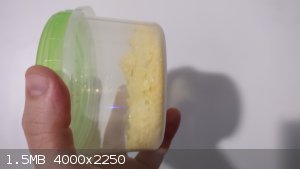
|
|
|
XeonTheMGPony
International Hazard
    
Posts: 1641
Registered: 5-1-2016
Member Is Offline
Mood: No Mood
|
|
best investment ever was a good vacuum filtering rig! I strongly recommend it, Second option is a thermal static warming pan and a few layers of paper
towel.
|
|
|
ManyInterests
National Hazard
   
Posts: 966
Registered: 19-5-2019
Member Is Offline
|
|
So my third batch is basically done, just some cooling time and then evaporating the rest still in order to squeeze out as much picric acid as
possible from this (and of course, the drying time!).
I found something rather interesting in this batch. I added too much water (as usual!) when crashing out the picric after the synthesis. I decided
that I could evaporate everything off AND basically do a recrystalization in one step. During my 2nd batch (this is my 3rd) I didn't add water to the
picric acid solution before crashing it in the ice. I didn't think it was necessary, but I realized I had made an error at that time.
I actually used 1600ml of water to crash it! I had too much picric still dissolved. when I boiled that water down I got to around 200ml with no
crystals until I left it to cool down and it became a solid chunk of picric acid. I then added all the crude picric acid I filtered out the first time
and 2000ml of distilled water for a recrystalization. It took a long time (excess of 24 hours) to evaporate down to 800ml before I saw plenty of the
red blob of impurities at the bottom and I decided it was a good time to decant it and get rid of the impurities.
It's being a fun experience making picric acid!
The pic shows the hot picric acid solution and the other shows the soldifying impurities (which are being neturalized with water and sodium
bicarbonate). Some tiny bit of the red blob came in, but I am confident that it is 99% pure.
My first two batches need to be ground up to get some consistent crystal size.
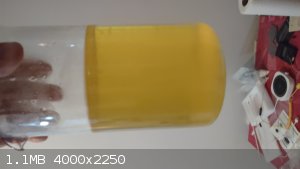 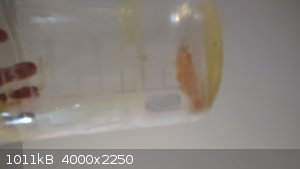
|
|
|
ManyInterests
National Hazard
   
Posts: 966
Registered: 19-5-2019
Member Is Offline
|
|
So after filtering I did boil down the remaining liquid by half or so, then I decided to let it cool down at room temp. Nothing crystalized, so I
decided to put it in the fridge (not the freezer) and most of what I assume is the picric solidified. I put them all in coffee filters and will wait
for them to fully filter out. The crystal sizes might be off, but once ground up, they'll be good for anything. In several hours I will squeeze out
what I got from them.
I cleaned up as much of the impurities as possible via Rosco's boiling method. This should be good.
I wasn't able to post the photos for some reason...
|
|
|
Herr Haber
International Hazard
    
Posts: 1236
Registered: 29-1-2016
Member Is Offline
Mood: No Mood
|
|
Adding water at the end of nitration dilutes the sulphuric acid in which PA is very soluble especially at high temperatures.
The only "annoying" part in this synthesis is knowing that you are going to lose a bit of product while getting rid of H2SO4 / water. It's otherwise
quite instructing.
I'm curious, how did you proceed from the mono to dinitration. Did you cool then heat again or did you "surf the exotherm" ?
Also, it seems you have discovered molten picric acid. Good thing there's a huge margin between melting and decomposition point 
The spirit of adventure was upon me. Having nitric acid and copper, I had only to learn what the words 'act upon' meant. - Ira Remsen
|
|
|
ManyInterests
National Hazard
   
Posts: 966
Registered: 19-5-2019
Member Is Offline
|
|
Quote: Originally posted by Herr Haber  | Adding water at the end of nitration dilutes the sulphuric acid in which PA is very soluble especially at high temperatures.
The only "annoying" part in this synthesis is knowing that you are going to lose a bit of product while getting rid of H2SO4 / water. It's otherwise
quite instructing.
I'm curious, how did you proceed from the mono to dinitration. Did you cool then heat again or did you "surf the exotherm" ?
Also, it seems you have discovered molten picric acid. Good thing there's a huge margin between melting and decomposition point 
|
How I went from the mono/dinitration to the trinitration is following Rosco's instructions. After adding all the nitrate salt (sodium in my case) I
kept stirring while heating it up to 120C and letting stay that way for around 5 minutes before letting the temperature go down (slowly) on the mantle
until it hit 100 or so before putting in the water to crash it, then crashing it out in distilled ice cubes.
right now most of the water seems to have dropped, which means I hope that I have a good crop of picric acid this time around! My fourth synth will
involve 75 grams of ASA to start. I will need to make sure I don't get a lot of foaming when I add the salt. But I think my beaker can handle it. The
foaming went up to the 800ml mark (and it is a 1000ml beaker).
I will still need to squeeze out the water tonight. I've been cooking so my apartment heated up, if it was doing to drop more water, the picric would
have done so now.
edit: I found Urbanski's Vol 2. Lemme look through it!
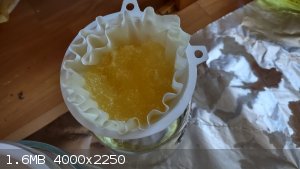
[Edited on 13-12-2022 by ManyInterests]
|
|
|
ManyInterests
National Hazard
   
Posts: 966
Registered: 19-5-2019
Member Is Offline
|
|
OK this is not good. I think I am doing something REALLY wrong with all my picric acid synthesis. I think the problem is that when I was trying to
boil down the mother liquor for more picric I realize that the stuff I was pulling out is really not something that should have been in contact with
my picric acid. I think I have been working at this VERY, VERY wrong, and the entire month of work has been for nothing!
This is the third batch I made. It turned all of the paper it was on to a very dark color, almost black. This is consistent with acid and it was still
very wet. I am confident it is wet with acid, not water.
My fourth batch's crude looked good, but I boiled down the remaining 1200 water (I am getting better at it, but that is still a little too much) and I
got almost white crystals that I thought might have been picric, but it was REALLy acid and was eating through the paper. This is not good since I
added it with the other crude picric (that did NOT burn through the paper filter) when adding it to the recrystalization. I hope it works out OK, I
won't be boiling down any more liquid. This is not terrible. I really don't want to have wasted all this time and effort for another crummy batch of
fake or super poor quality picric acid. 
Edit: At least I am learning. Even if it means a lot of time and resources spent on this. Making good picric acid is difficult. No wonder it replaced
by so many other stuff.
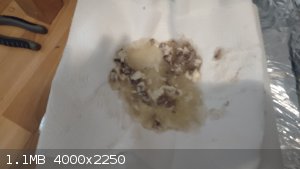
[Edited on 15-12-2022 by ManyInterests]
|
|
|
B(a)P
International Hazard
    
Posts: 1139
Registered: 29-9-2019
Member Is Offline
Mood: Festive
|
|
Quote: Originally posted by ManyInterests  | OK this is not good. I think I am doing something REALLY wrong with all my picric acid synthesis. I think the problem is that when I was trying to
boil down the mother liquor for more picric I realize that the stuff I was pulling out is really not something that should have been in contact with
my picric acid. I think I have been working at this VERY, VERY wrong, and the entire month of work has been for nothing!
This is the third batch I made. It turned all of the paper it was on to a very dark color, almost black. This is consistent with acid and it was still
very wet. I am confident it is wet with acid, not water.
My fourth batch's crude looked good, but I boiled down the remaining 1200 water (I am getting better at it, but that is still a little too much) and I
got almost white crystals that I thought might have been picric, but it was REALLy acid and was eating through the paper. This is not good since I
added it with the other crude picric (that did NOT burn through the paper filter) when adding it to the recrystalization. I hope it works out OK, I
won't be boiling down any more liquid. This is not terrible. I really don't want to have wasted all this time and effort for another crummy batch of
fake or super poor quality picric acid. 
Edit: At least I am learning. Even if it means a lot of time and resources spent on this. Making good picric acid is difficult. No wonder it replaced
by so many other stuff.
[Edited on 15-12-2022 by ManyInterests] |
If I understand you correctly you filtered out a crop of picric acid crystals, then you boiled down what remained and the next crop of crystals (white
crystals) is what you have shown in the image? You then added those white crystals to your first crop of crystals? Or possibly all of your picric
acid? I would do a recrystallisation of the batch containing these white crystals, keep the first batch of crystals and discard (appropriately) what
remained.
|
|
|
ManyInterests
National Hazard
   
Posts: 966
Registered: 19-5-2019
Member Is Offline
|
|
The picture is from my third batch. I will describe everything on what happened.
The synthesis went normal, but I used too much water and too much ice to crash the picric in, the result is I had almost no crystals filtered out. I
decided to just boil everything down. Look up at the post where I have two pictures of my beaker, this is what I was describing. After filtering that
stuff down, I boiled the stuff even more and I got what I thought was more picric, but it must have been REAL dirty since it was eating away at the
paper filter.
I hated it so much that I neutralized it with sodium bicarbonate and just dumped the sodium picrate with large amounts of water down the drain. I hate
having to do that, but this is not a good batch at all and I cannot mix it with anything else.
I hope my fourth batch doesn't suffer the same fate!
Edit: for my fourth batch, I am doing a recrystalization now. I added everything to 2100 of distilled water and I am boiling it down, there are some
insoluble bits floating around, but most of them have dissolved. I will boil them until they get to around 600ml then filter them out. After I collect
the crystals from all those, I will discard the left over liquid.
[Edited on 15-12-2022 by ManyInterests]
|
|
|
| Pages:
1
..
26
27
28
29
30
31 |